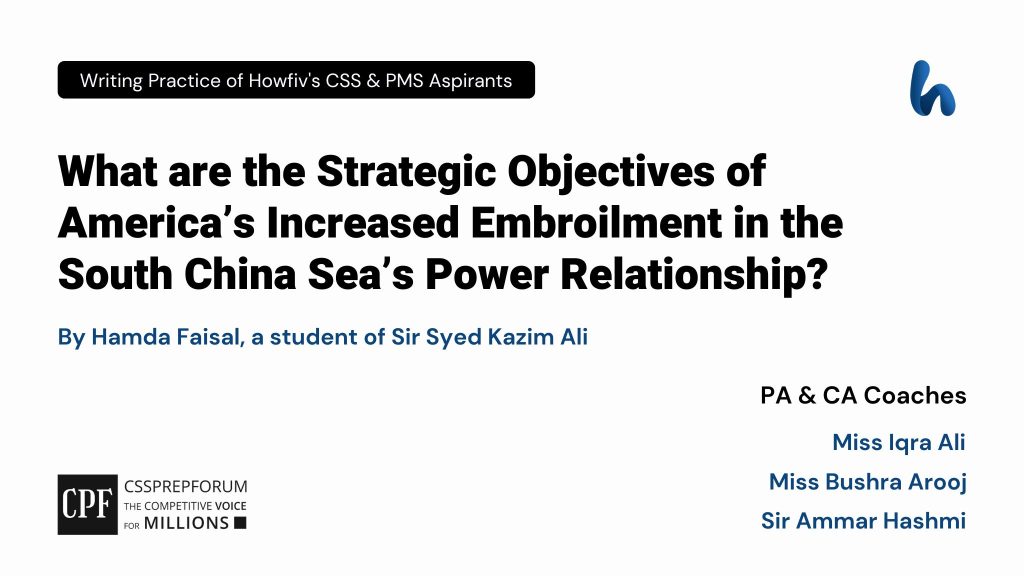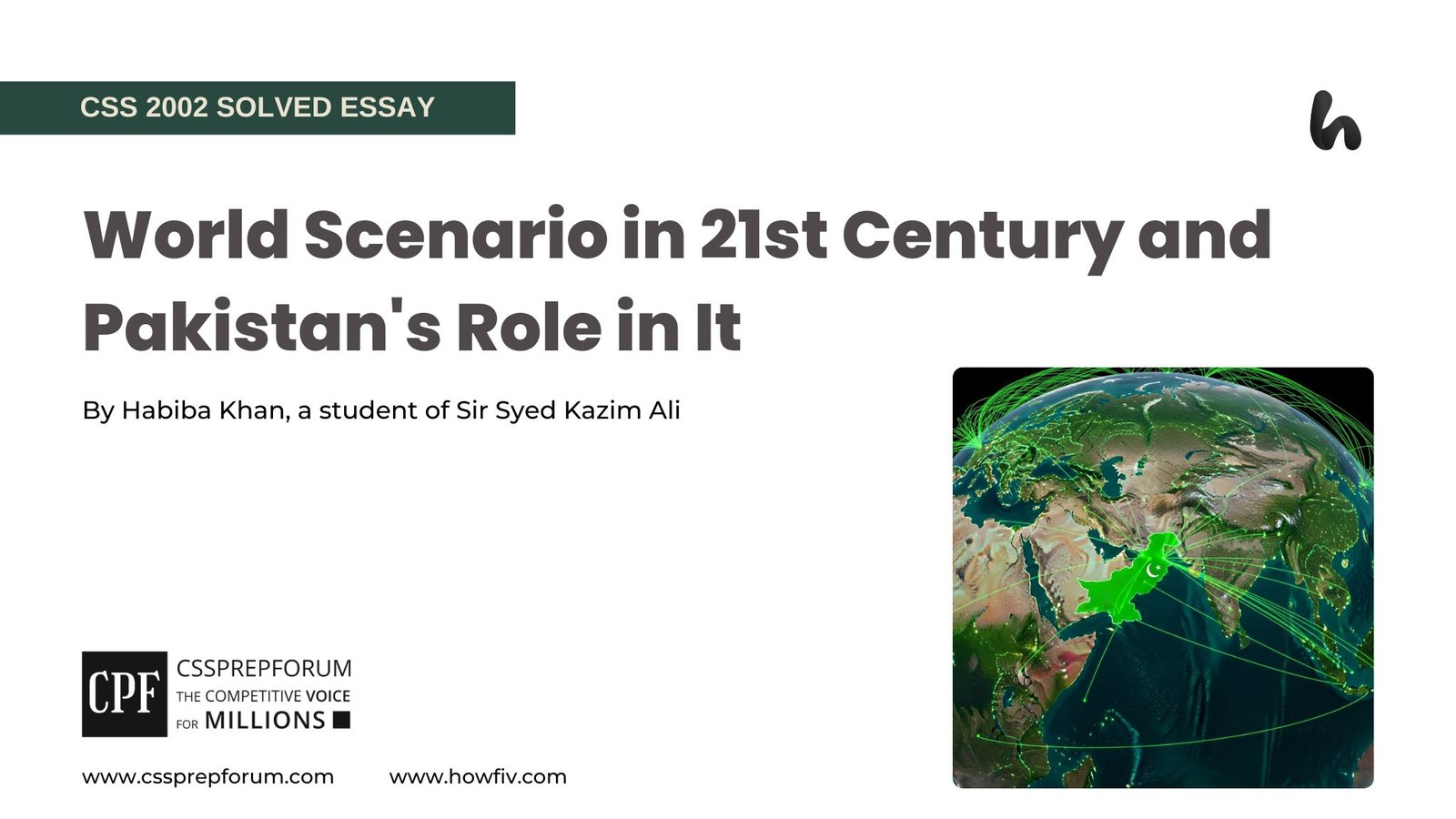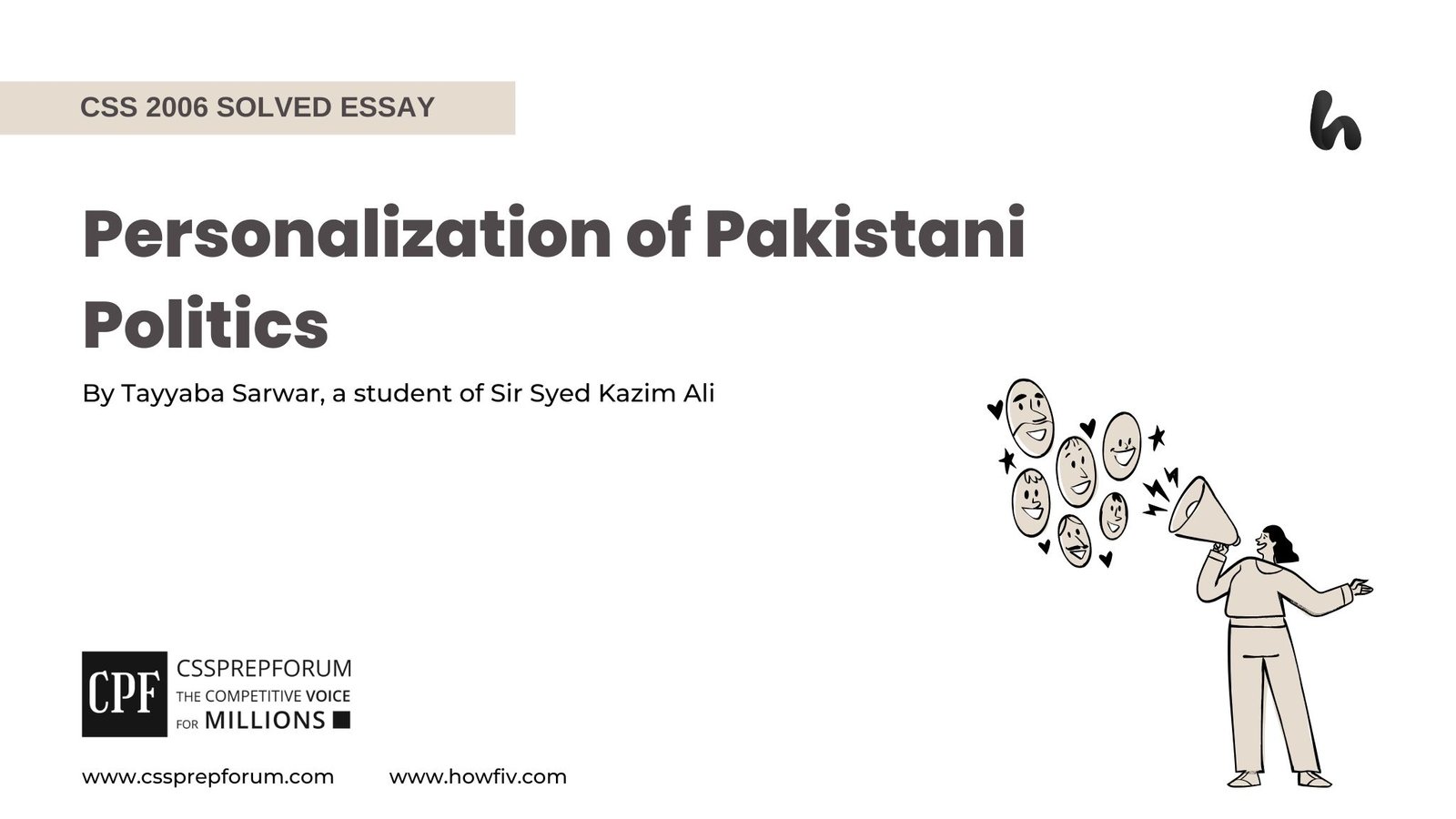CSS Current Affairs | America’s Embroilment in the South China Sea
The following question of CSS Current Affairs is solved by Hamda Faisal under the supervision of Howfiv’s Pakistan Affairs and Current Affairs Coaches. She learnt how to attempt 20 marks question and essay writing from Sir Syed Kazim Ali, Pakistan’s best CSS and PMS English essay and precis teacher with the highest success rate of his students. This solved past paper question is attempted on the pattern taught by Sir to his students, scoring the highest marks in compulsory and optional subjects for years, and uploaded to help aspirants understand how to crack a topic or question, how to write relevantly, what coherence is, and how to include and connect ideas, opinions, and suggestions to score the maximum.

Outline
1- Introduction
2- Understanding the South China Sea’s Power Relationship
3- Strategic Objectives of America’s Increased Embroilment in the South China Sea’s Power Relationship
- ✓To counter China’s growing influence and power
- ✓To ensure freedom of navigation and communication
- ✓To safeguard the overall interests of its allies
- ✓To gain a tactical advantage against future threats
- ✓To maintain the status quo in the Indo-Pacific
- ✓To influence holdings over resources
4- Critical analysis
5- Conclusion

Answer to the Question
Introduction
The South China Sea is located amidst the East Asian littoral states like Taiwan, the Philippines, Vietnam, Malaysia, Brunei, and the major stakeholder China. It connects with the Indian Ocean through the Strait of Malacca and with the Pacific Ocean through the Straits of Taiwan and Formosa. Indeed, it holds immense geostrategic importance and acts as an arena for a tussle of power between the major players. An estimated 21 per cent of global trade passes through the South China Sea, amounting to 3.37 trillion dollars, according to the United Nations Conference on Trade and Development (UNCTAD). Thus, the South China Sea hold economic and political benefits for whoever controls its routes, resources, and territory. It has emerged as a playground for the US-China strategic competition over the past decades, justifying the increased embroilment of the United States in the Indo-Pacific region. This attempt explains the many strategic objectives hidden behind the involvement of the U.S. in the South China Sea.
Understanding the South China Sea’s Power Relationship
Before moving on to the U.S. embroilment, it is imperative to understand the South China Sea’s power relationship. As per international laws, each country has an Exclusive Economic Zone (EEZ) of around 200 nautical miles seaward from its coastal boundaries. However, the EEZs of the littoral states in the South China Sea overlap and are claimed by many. For instance, the People’s Republic of China has published a map with a nine-dash line since 1952, claiming far more maritime territory by citing four-thousand-year-old dynastical maps. It has resulted in the disputed and often-fought-upon territories like the Paracel Islands, the Spratly Islands, and Scarborough Shoal in the South China Sea with the Philippines, Vietnam, and Taiwan. Moreover, various issues like regular collisions between China and the Philippines, artificial island-building and base construction, and a tribunal at the Permanent Court of Attribution expose the power relationship, which is mainly tipped in China’s favour. As such, the South China Sea is a web of complex relationships, which is only being aggravated by the United States’ presence in the region.
Strategic Objectives of America’s Increased Embroilment in the South China Sea’s Power Relationship
Ever since World War II, the United States of America has taken it upon itself to intervene and maintain peace in turbulent regions around the world. Likewise, in the South China Sea, the U.S. keeps its presence and embroilment in the power relationship to guard its homeland, have military access, and maintain a favourable balance of power. The following are the strategic objectives of America’s increased embroilment in the South China Sea’s power relationship.
- ✓To counter China’s growing influence and power
The main objective of the U.S. presence in the South China Sea is its policy of countering and containing China’s increased influence and say in geostrategic and geopolitical matters. To the U.S., China’s nine-dash map is a direct infringement of international laws. For instance, the United Nations Convention on the Law of the Sea (UNCLOS) grants countries sovereignty in a 200 nautical miles region, termed Exclusive Economic Zones (EEZs), seaward from the coast. However, China’s declared map and past military activities in the region reaching as far as the Spratly Islands are beyond the lawful territory. Therefore, with its bold denial of the mandated territory, the U.S. perceives it as a threat to mitigate and counties to increase its involvement in the South China Sea.
- ✓To ensure freedom of navigation and communication
Moving on, the U.S. presence in the region is to ensure freedom of navigation and establish lines of sea communication. As various countries in the region have participated in activities like artificial island building to falsely enhance their EEZs and bypass international laws, a complex power relationship has emerged, resulting in collisions, military drills, and intimidation. According to the U.S. Congressional Research Service (CRS), the Freedom of Navigation Operations (FON) is one of the significant objectives of the country’s state policy. The U.S. wants to guarantee safe routes and navigation of not only trade vessels but also military ships, for it wants to hold a strategic position against the Chinese Anti Access and Area Denial (A2/AD) in the South China Sea in the off-chance of a conflict with China. Therefore, the U.S. is increasingly meddling in the region to access and guard routes for navigation and communications.
- ✓To safeguard the overall interests of its allies
In addition, the U.S. has a policy of standing by and safeguarding its allies around the globe, and it’s the same for its allies in the South China Sea, namely the Philippines, Taiwan, South Korea, and Japan. In 1951, the U.S. signed a Mutual Defence Treaty with the Philippines. It states that in case of an invasion of the latter, the former would launch a formal war to guard the political, social, and economic interests of both parties. Moreover, the U.S. has reiterated this policy recently and applied it to open conflicts in the South China Sea as well. In brief, the strategic objective here for the U.S. to increase its influence is to maintain a favourable balance of power and safeguard allies’ overall interests.
- ✓To gain a tactical advantage against future threats
Moreover, the U.S. holds strategic points around the globe to have a tactical advantage in preparation for potential threats. The same strategic objectives lie behind its involvement in the South China Sea. For instance, according to the U.S. Department of Defence’s Military and Security Development Report Involving the People’s Republic of China 2022, in case of possible conflict with the latter, the U.S. military ships would not be able to cross the first island chain—namely Japan and the Philippines. As such, it is in the tactical and strategic interest of the U.S. to keep its presence in the South China Sea, for an economic and military conflict with the rival demands it to maintain an advantageous position. Therefore, the U.S. stands to gain ground in exchange for its embroilment in the region.
- ✓To maintain the status quo in the Indo-Pacific
Likewise, the U.S. is a self-proclaimed guarantee of international peace and has meddled in international affairs since its hegemonic emergence after the Cold War to maintain the status quo in different regions. It is against China’s bold moves, such as the rejection of the decision of the Permanent Court of Attribution 2016 and other warnings. As a tent of the U.S. state policy, even reaffirmed by the Biden Administration, it is “opposed to any unilateral attempts to change the status quo” in the South China Sea. The statement marks China as a disruptor of power relationships and emphasises the U.S. attitude of countering it. Therefore, the U.S. is actively engaging in the South China Sea to balance the status quo in the Indo-Pacific region.
- ✓To influence holdings over resources
Lastly, underlining all the power tussles in the South China Sea are the potential and undiscovered natural resources like petroleum, natural gas, and lucrative fishing spots. Each country is seeking a monopoly to extract those resources, and the U.S., as always, is trying to influence the relationships. The U.S. Energy Information Administration, on account of exploration conducted by Rystad Energy, estimates around 3.6 billion barrels of petroleum and 40.3 trillion cubic feet of natural gas reserves in the South China Sea. It is evident that the country that holds the power over these resources stands to benefit in a global world order stratified by energy crises. Therefore, the U.S. has increased its embroilment in the South China Sea power relationship to influence the holdings of vital energy resources.
Critical analysis
In a critical overview, the South China Sea is an intermingling web of power relationships. It is steadily moving towards being completely overtaken by China’s influence, thereby making it a hot arena for U.S.-China competition and tussles. The U.S. has underlined the discussed objectives behind its involvement in the region. Indeed, the region stands at the precipice of tipping like the Cold War or the War on Terror. However, international geopolitics are extremely volatile. China’s policy of soft power and economic influence counterweights the U.S.’s hard policy of navy navigation and invasion. Therefore, it can be analysed that the region will stay in a perpetual state of tussle without ever reaching a boiling point.
Conclusion
In brief, the strategic objectives behind America’s increased embroilment in the South China Sea’s power relationship are to safeguard its political and economic interests globally. The South China Sea, and the Indo-Pacific region at large, is a geostrategic arena; whoever holds it can influence the future of geopolitics and geoeconomics. That much is evident from China’s strategies of nine-dash, artificial island building, and denial of the UNCLOS and the Permanent Court of Attribution hearing. Moreover, the U.S. policies and report documents, such as the Mutual Defence Treaty with the Philippines, the Freedom of Navigation Operations, and various policy documents by its Congress and the Department of Defence, point to the same conclusion. As a result, an increasingly complex web of relationships is being observed in the South China Sea with time. While it would be a premature judgment to declare the possibility of a head-on collision between the major powers, the South China Sea is the next arena of international politics with its lucrative resources and political advantages

CSS Solved Past Papers’ Essays
Looking for the last ten years of CSS and PMS Solved Essays and want to know how Sir Kazim’s students write and score the highest marks in the essays’ papers? Then, click on the CSS Solved Essays to start reading them.
CSS Solved Essays
CSS Solved General Science & Ability Past Papers
Want to read the last ten years’ General Science & Ability Solved Past Papers to learn how to attempt them and to score high? Let’s click on the link below to read them all freely. All past papers have been solved by Pakistan’s top CSS GSA coach having the highest score of their students.
General Science & Ability












